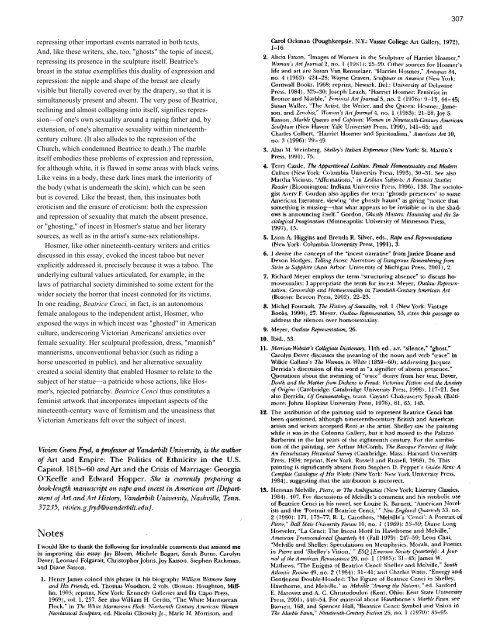of Incest and Female Relations in Harriet Hosmer's Beatrice Cenci
of Incest and Female Relations in Harriet Hosmer's Beatrice Cenci
of Incest and Female Relations in Harriet Hosmer's Beatrice Cenci
Create successful ePaper yourself
Turn your PDF publications into a flip-book with our unique Google optimized e-Paper software.
epress<strong>in</strong>g other important events narrated <strong>in</strong> both texts.<br />
And, like these writers, she, too, "ghosts" the topic <strong>of</strong> <strong>in</strong>cest,<br />
repress<strong>in</strong>g its presence <strong>in</strong> the sculpture itself. <strong>Beatrice</strong>'s<br />
breast <strong>in</strong> the statue exemplifies this duality <strong>of</strong> expression <strong>and</strong><br />
repression: the nipple <strong>and</strong> shape <strong>of</strong> the breast are clearly<br />
visible but literally covered over by the drapery, so that it is<br />
simultaneously present <strong>and</strong> absent. The very pose <strong>of</strong> <strong>Beatrice</strong>,<br />
recl<strong>in</strong><strong>in</strong>g <strong>and</strong> almost collaps<strong>in</strong>g <strong>in</strong>to itself, signifies repres-<br />
sion—<strong>of</strong> one's own sexuality around a rap<strong>in</strong>g father <strong>and</strong>, by<br />
extension, <strong>of</strong> one's alternative sexuality with<strong>in</strong> n<strong>in</strong>eteenth-<br />
century culture. (It also alludes to the repression <strong>of</strong> the<br />
Church, which condemned <strong>Beatrice</strong> to death.) The marble<br />
itself embodies these problems <strong>of</strong> expression <strong>and</strong> repression,<br />
for although white, it is flawed <strong>in</strong> some areas with black ve<strong>in</strong>s.<br />
Like ve<strong>in</strong>s <strong>in</strong> a body, these dark l<strong>in</strong>es mark the <strong>in</strong>teriority <strong>of</strong><br />
the body (what is underneath the sk<strong>in</strong>), which can be seen<br />
but is covered. Like the breast, then, this <strong>in</strong>s<strong>in</strong>uates both<br />
eroticism <strong>and</strong> the erasure <strong>of</strong> eroticism: both the expression<br />
<strong>and</strong> repression <strong>of</strong> sexuality that match the absent presence,<br />
or "ghost<strong>in</strong>g," <strong>of</strong> <strong>in</strong>cest <strong>in</strong> <strong>Hosmer's</strong> statue <strong>and</strong> her literary<br />
sources, as well as <strong>in</strong> the artist's same-sex relationships.<br />
Hosmer, like other n<strong>in</strong>eteenth-century writers <strong>and</strong> critics<br />
discussed <strong>in</strong> this essay, evoked the <strong>in</strong>cest taboo but never<br />
explicitly addressed it, precisely because it was a taboo. The<br />
underly<strong>in</strong>g cultural values articulated, for example, <strong>in</strong> the<br />
laws <strong>of</strong> patriarchal society dim<strong>in</strong>ished to some extent for the<br />
wider society the horror that <strong>in</strong>cest connoted for its victims.<br />
In one read<strong>in</strong>g, <strong>Beatrice</strong> <strong>Cenci</strong>, <strong>in</strong> fact, is an autonomous<br />
female analogous to the <strong>in</strong>dependent artist, Hosmer, who<br />
exposed the ways <strong>in</strong> which <strong>in</strong>cest was "ghosted" <strong>in</strong> American<br />
culture, underscor<strong>in</strong>g Victorian Americans' anxieties over<br />
female sexuality. Her sculptural pr<strong>of</strong>ession, dress, "mannish"<br />
mannerisms, unconventional behavior (such as rid<strong>in</strong>g a<br />
horse unescorted <strong>in</strong> public), <strong>and</strong> her alternative sexuality<br />
created a social identity that enabled Hosmer to relate to the<br />
subject <strong>of</strong> her statue—a patricide whose actions, like Hos-<br />
mer's, rejected patriarchy. <strong>Beatrice</strong> <strong>Cenci</strong> thus constitutes a<br />
fem<strong>in</strong>ist artwork that <strong>in</strong>corporates important aspects <strong>of</strong> the<br />
n<strong>in</strong>eteenth-century wave <strong>of</strong> fem<strong>in</strong>ism <strong>and</strong> the uneas<strong>in</strong>ess that<br />
Victorian Americans felt over the subject <strong>of</strong> <strong>in</strong>cest.<br />
307
















